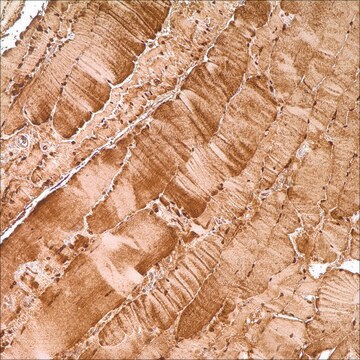MABN1871
Anti-HCN4 Antibody, clone PG2-1A4
clone PG2-1A4, from rat
Synonyme(s) :
Potassium/sodium hyperpolarization-activated cyclic nucleotide-gated channel 4, Brain cyclic nucleotide-gated channel 3, BCNG-3
About This Item
Produits recommandés
Source biologique
rat
Niveau de qualité
Forme d'anticorps
purified immunoglobulin
Type de produit anticorps
primary antibodies
Clone
PG2-1A4, monoclonal
Espèces réactives
mouse
Conditionnement
antibody small pack of 25 μL
Technique(s)
electron microscopy: suitable
immunofluorescence: suitable
immunohistochemistry: suitable
western blot: suitable
Isotype
IgG2aκ
Numéro d'accès UniProt
Conditions d'expédition
ambient
Modification post-traductionnelle de la cible
unmodified
Informations sur le gène
mouse ... Hcn4(330953)
Description générale
Spécificité
Immunogène
Application
Immunohistochemistry Analysis: A 1:100-500 dilution from a representative lot detected HCN4 in Mouse (C57BL/6) retina tissues (Courtesy of Prof. Dr. Frank Müller, Institute of Complex Systems, Cellular Biophysics (ICS-4), Forschungszentrum Jülich, Germany).
Electron Microscopy Analysis: A representative lot detected HCN4 in Electron Microscopy applications (Mataruga, A., et. al. (2007). J Comp Neurol. 502(6):1123-37).
Immunohistochemistry Analysis: A representative lot detected HCN4 in Immunohistochemistry applications (Cichy, A., et. al. (2015). J Neurosci. 35(9):4025-39; Mataruga, A., et. al. (2007). J Comp Neurol. 502(6):1123-37).
Western Blotting Analysis: A representative lot detected HCN4 in Western Blotting applications (Muller, F., et. al. (2003). Eur J Neruosci. 17(10):2084-96).
Qualité
Isotyping Analysis: The identity of this monoclonal antibody is confirmed by isotyping test to be mouse IgG2a.
Description de la cible
Forme physique
Autres remarques
Vous ne trouvez pas le bon produit ?
Essayez notre Outil de sélection de produits.
Code de la classe de stockage
12 - Non Combustible Liquids
Classe de danger pour l'eau (WGK)
WGK 1
Certificats d'analyse (COA)
Recherchez un Certificats d'analyse (COA) en saisissant le numéro de lot du produit. Les numéros de lot figurent sur l'étiquette du produit après les mots "Lot" ou "Batch".
Déjà en possession de ce produit ?
Retrouvez la documentation relative aux produits que vous avez récemment achetés dans la Bibliothèque de documents.
Notre équipe de scientifiques dispose d'une expérience dans tous les secteurs de la recherche, notamment en sciences de la vie, science des matériaux, synthèse chimique, chromatographie, analyse et dans de nombreux autres domaines..
Contacter notre Service technique